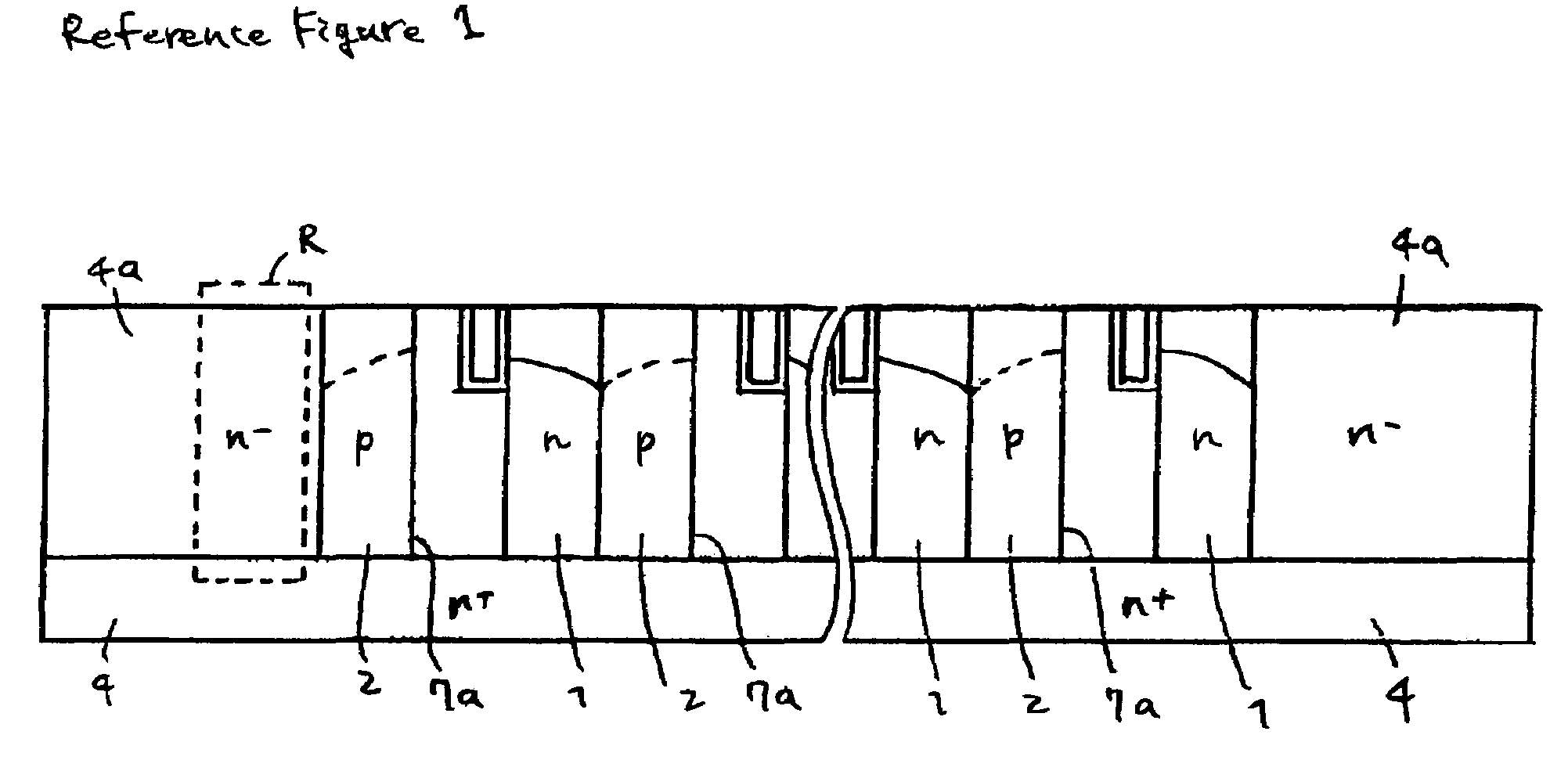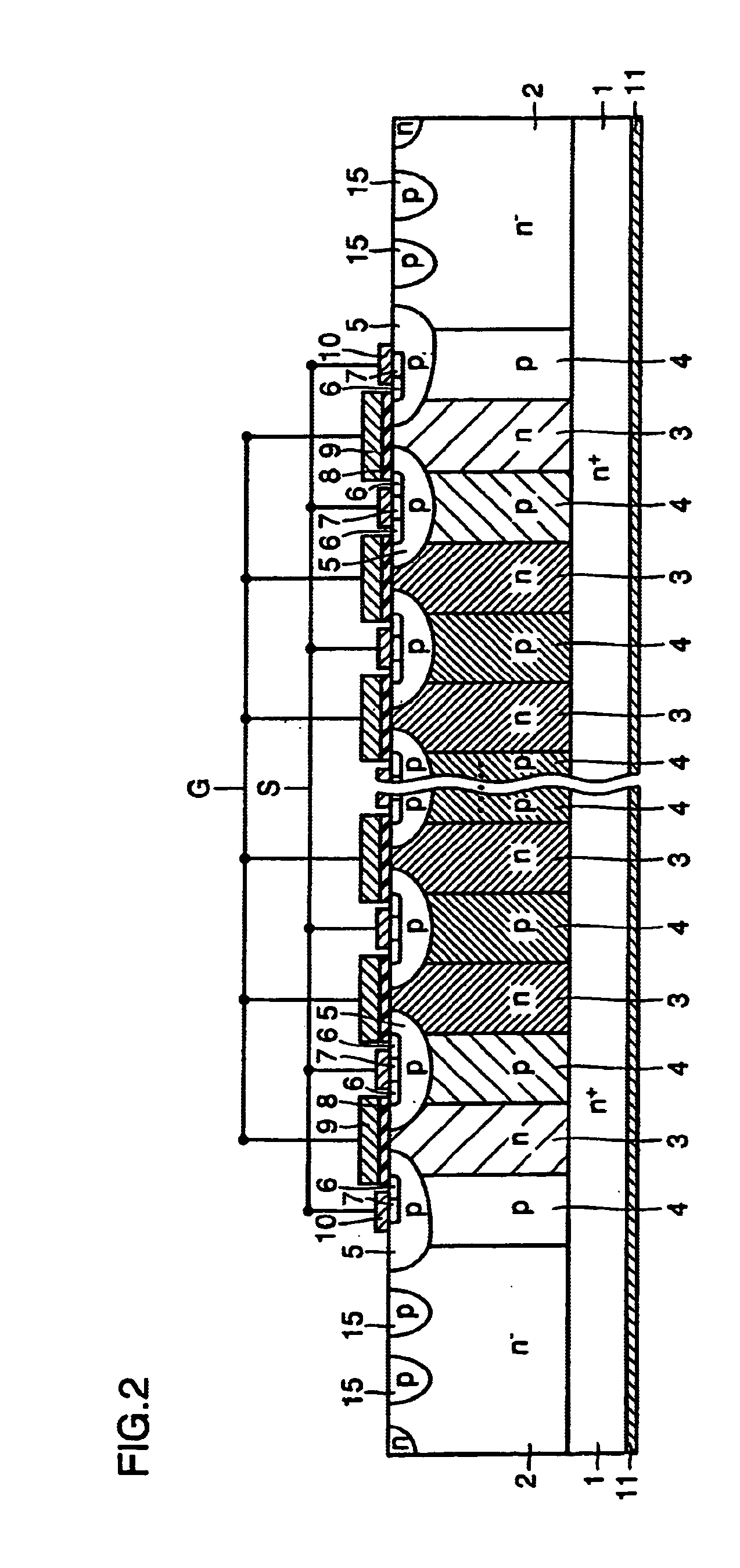Semiconductor device and manufacturing method for the same
a technology of semiconductors and semiconductors, applied in the direction of semiconductor devices, basic electric elements, electrical appliances, etc., can solve the problems of low main withstand voltage, low on resistance, and large drop in main withstand voltage,
- Summary
- Abstract
- Description
- Claims
- Application Information
AI Technical Summary
Benefits of technology
Problems solved by technology
Method used
Image
Examples
first embodiment
[0200](First Embodiment)
[0201]FIG. 1 shows a configuration that corresponds to the case wherein a MOS-FET is posited as a concrete active element structure. In reference to FIG. 1, an n− epitaxial layer 2 is formed on the first main surface side of an n+ drain region 1 of the MOS-FET. A pn-repeating structure is formed within this n− epitaxial layer 2 wherein n-type drift regions 3 and p-type impurity regions 4 are repeated in alternation.
[0202]Here, the vicinity of the center of the element having this pn-repeating structure is omitted for simplification of explanation and the pitch of pn repetition is approximately 1 μm to 20 μm and, therefore, several hundreds to several tens of thousands of pairs of n-type drift regions 3 and p-type impurity regions 4 usually exist in the form of repeated combinations in this portion. The n-type impurity concentration of an n-type drift region 3 and the p-type impurity concentration of a p-type impurity region 4, which are combined in a pair, ar...
second embodiment
[0221](Second Embodiment)
[0222]In reference to FIG. 2, the configuration of the present invention differs from the configuration shown in FIG. 1 in the point that the present embodiment has a configuration wherein the concentrations of n-type drift regions 3 and p-type impurity regions 4 are independently lowered to get lesser in an alternating manner in the direction toward the edge portion side in four stages without using each combination of n-type drift region 3 and p-type impurity region 4 (hereinafter referred to as a pn combination) as one unit. That is to say, p-type impurity region 4 located at the outermost portion of the pn-repeating structure is a region of extremely low concentration having the lowest impurity concentration. n-type drift region 3 adjoining this p-type impurity region 4 at the outermost portion is a low concentration region having the next lowest impurity concentration. p-type impurity region 4 adjoining this n-type drift region 3 on the center portion s...
third embodiment
[0228](Third Embodiment)
[0229]In reference to FIG. 3, the configuration of the present embodiment differs from the configuration of the first embodiment in the point wherein the low concentration region at the outermost portion of the pn-repeating structure in the configuration of the present embodiment is formed of only one pair of the pn combination, which is one unit. That is to say, the pair formed of the pn combination 3 and 4 located at the outermost portion of the pn-repeating structure has the same impurity concentration and has an impurity concentration lower than that of the high concentration regions 3 and 4 in the center portion.
[0230]In addition, as for the concentration setting of the respective regions in the case that the concentration gradient has only one stage, as in the present embodiment, the impurity concentration of each of the low concentration regions 3 and 4 is preferably no less than 30% and no greater than 70% in the case that the impurity concentration o...
PUM
 Login to View More
Login to View More Abstract
Description
Claims
Application Information
 Login to View More
Login to View More - R&D
- Intellectual Property
- Life Sciences
- Materials
- Tech Scout
- Unparalleled Data Quality
- Higher Quality Content
- 60% Fewer Hallucinations
Browse by: Latest US Patents, China's latest patents, Technical Efficacy Thesaurus, Application Domain, Technology Topic, Popular Technical Reports.
© 2025 PatSnap. All rights reserved.Legal|Privacy policy|Modern Slavery Act Transparency Statement|Sitemap|About US| Contact US: help@patsnap.com



